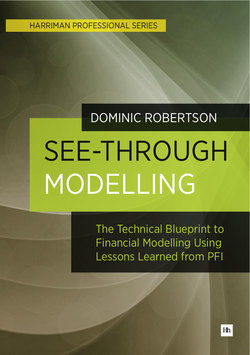Читать книгу See-Through Modelling - Dominic Robertson - Страница 17
На сайте Литреса книга снята с продажи.
Lessons learnt from PFI Use of Microsoft Excel for financial modelling
ОглавлениеMicrosoft Excel has become the tool of choice for financial and business modelling, and the UK PFI has gone a long way to prove this. The 900 or so UK PFI projects have required meticulous planning, reporting and human interchange, and this has all been done in Microsoft Excel. This is not withstanding the availability of many other software solutions.
As with most solutions Excel has its strengths and its weaknesses. First the strengths:
Flexibility – Excel is a simple grid across as many sheets as the user needs with the power to add formulae in multiple cells.
Grid structure – this is ideal for organised data such as a financial model.
Ubiquity – all offices are now equipped with Excel so everyone will be able to open the file.
Standardisation – with an increasing drive towards standardisation Excel is proving that it can perform better.
Now the weaknesses:
Flexibility – Excel allows just about anything the user wants in terms of content, formatting and structure which makes the software very error-prone and open to abuse.
Grid structure – this can be rigid as the 2-dimensionality of each sheet precludes multi-dimensional modelling.
Ubiquity – since everyone has Excel this means that experiments in new, more specialised, software are generally doomed to failure.
In order to widen the market as much as possible the original designers of Excel began with the objective of making the software as flexible as possible. To this end they have succeeded as the Microsoft Office package, which includes Excel, is now quasi-ubiquitous amongst the business community worldwide.
As a result of this flexibility, when using Excel for relatively complex tasks such as financial modelling there has been a need to impose some rigidity and structure on the software. The FAST modelling standard – outlined later in this book – does exactly that.
Excel is currently the best solution for financial modelling.
